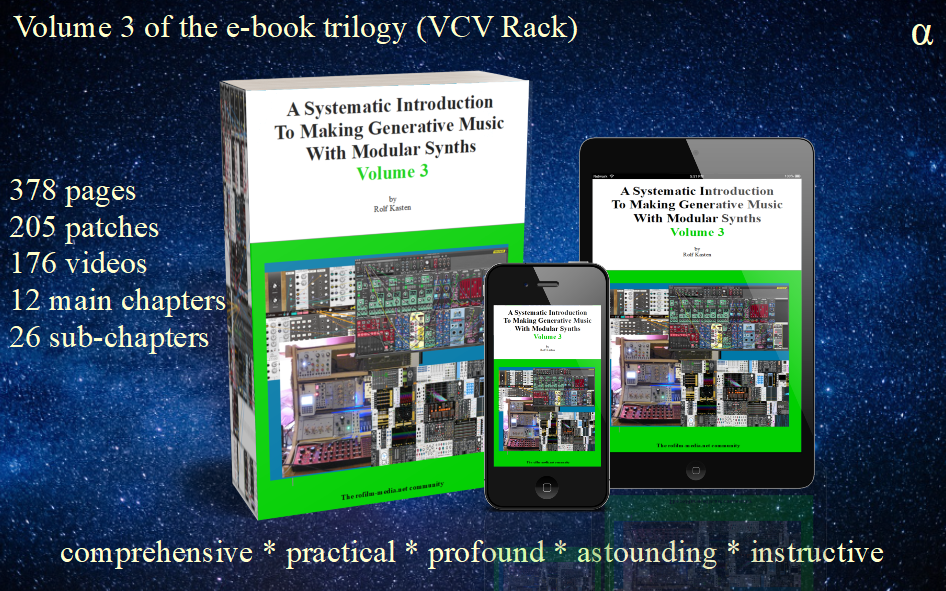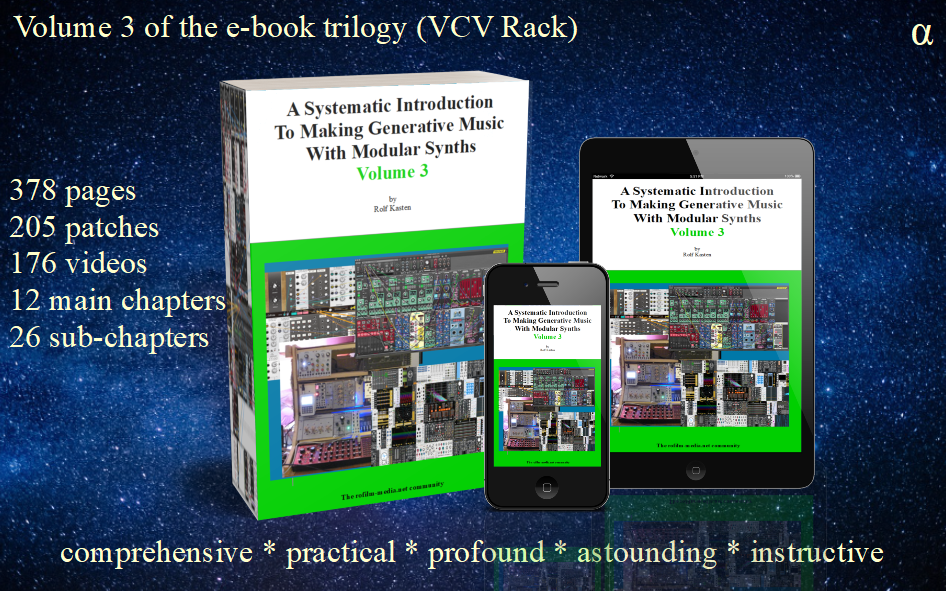A Systematic Introduction To Making Generative Music With Modular Synths - Volume 3 (click and learn more about the book)
A Systematic Introduction To Making Generative Music With Modular Synths - Volume 3 (click and learn more about the book)


Content
Chapter 0: Some Words About This Book 005
PART I: Structures And Techniques
Chapter 1: Multi-Level Random Switches Triggers
And Gates 009
Chapter 2: Scale Modulations 018
Chapter 2.1: Methods Of Generative Transposing 018
Chapter 2.2: Randomly Replacing
Some Individual Notes 034
Chapter 3: Aspects Of Generative Polyphony 051
Chapter 3.1: A First Orientation In the World Of Generative Polyphony 052
Chapter 3.2: Different Speeds And Envelopes 057
Chapter 3.3: Rhythm Is Your Friend 068
Chapter 3.4: How To Avoid Small Intervals 072
Chapter 3.5: A Whiff Of Classic 083
Chapter 3.6: Another Whiff Of Classic 088
Chapter 3.7: About DC Offset With Shift Registers,
Clock Dividers and Trigger Delays 093
Chapter 3.8: Quantised Versus Not Quantised 100
Chapter 3.9: About Structure And Polyphony 104
Chapter 4: Miscellaneous Compositional Measures 110
Chapter 4.1: Making Note Length Pitch Dependent 110
Chapter 4.2: Giving a Direction To a
Random CV Succession 113
Chapter 4.3: Substituting Certain Notes
Of a Scale Or Pattern 118
Chapter 4.4: Quantised And Unquantised
Running Parallel 124
Chapter 4.5: Shift Register And Random Gates
Go Hand In Hand 125
Chapter 4.6: Stereo Position Of Similar Timbres 127
Chapter 4.7: A Whiff Of Wagner 130
Chapter 4.8: Scale Dependency Of Timbre 134
Chapter 4.9: Diverse Speed Dependencies 140
Chapter 4.10: “Mixed Stochastic” Or
“Blending Random Sonic Processes” 142
Chapter 5: Diverse Titbits 150 Chapter 5.1: Jumping Glides 150
Chapter 5.2: Sequencer And S&H 155
Chapter 5.3: Mixed Pitch And Filter Modulation 158
Chapter 5.4: Unsynchronised Envelopes 164
Chapter 5.5: One Envelope – Different Outcomes 169
Chapter 5.6: Randomly Rhythmical Pitches
Over Human Voice 172
Chapter 6: Composing And Scripting Generative Music 174
PART II: Projects And Approaches
Chapter 7: Approach 1 – Spontaneous And Unplanned 191
Chapter 8: Approach 2: - A Generative Puzzle 244
Chapter 9: Approach 3: Delirium 284
Chapter 10: Approach 4:
Interfering: Playing the Generative 307
Chapter 11: Approach 5: A Composition 325
Chapter 12: Epilogue 371
Appendix A: Your Personal Advantages
As a Buyer Of this Book 375
Appendix B: Contact And Social Media 377
Appendix C: Copyright 378
Chapter 0:
Some Words About This Book
This volume 3 is a bit different from the first 2 volumes.
First, it has two independent parts. Part 1 resembles the way I dealt with topics in the previous volumes, but there´s no “red line” through the chapters. Each chapter is independent from the others, and there´s no progression in complexity from chapter to chapter. This is because part I of this volume 3 shall fill gaps, which had to be left open in volumes 1 and 2. In this respect it´s a very practical part, describing techniques and structures which are meant to be directly used in your daily work – more or less “as they are”, and only changed in smaller details.
But there´s also a chapter of more theoretical character. This chapter (chapter 6) is dedicated to the possibly most composing-like and planned way to produce generative music using modular synths. This is a controversial matter indeed. I opened a discussion about it in a Facebook group some time ago, and the emotions went high! Well, take your own look – and your own stance then.
Part 2 is a different kind of animal. Here I describe real generative projects. No parts, no certain tricks or techniques, but complete projects and patches. Part 2 is “real world patching”.
But this part is more than just a couple of really large and complex patches. This chapter shows different approaches to producing generative music with modular synths – different approaches and different reasons.
There is the “let me just start somehow and look where the wind will take me” approach (I´d like to call it the improvising, the off-the-wall approach).
And there is the complete opposite: taking a piece of paper (or rather a couple of pieces) and write down and draw as many details, which the sonic outcome of the patch shall contain and how they shall develop – and only then go and start patching. Let me call this (with a smile on my face) the “Beethoven approach”.
And there is a given video or series of drawings and other media which need a sound track, a sound track that shall be generative. I call this the “multi-media approach”.
And there is a (more or less) ready made piece of generative music. It´s ready, it´s done – but it´s only in your mind. You hear (nearly) all of the details, you hear them that clearly and wonderful, that you are able to enjoy what your brain is playing back for you, but now, of course, you want to make make this piece a real thing. In other word: you have to patch what your mind is making you crazy with. I call this
the “delirium approach” (and there´s a deeper reason for this term – just read the chapter about it).
Like in the first 2 volumes of this trilogy I use the free version of VCV Rack to show the described techniques and patches. Everybody shall be able to follow and to recreate what I´m writing about.
Some of the patches – especially in part II – would get quite a bit smaller, if I used specific VCV Rack modules. But I want to make the patch examples as compatible and universal as possible. You should be able to recreate them using your own modular equipment (Software as well as hardware).
In some patches I use a certain module more than only once, even if this module offers more than only 1 output or input, so that I could use one single module for a couple of tasks instead of using a couple of these modules. I do so to make it easier to see the structure of the patch.
In some patches I use VCA modules to fade audio in and out instead of directly using the mixer´s fader modulation input jacks. Again: I do so to make the patch better “visible” and less chaotic looking with a lot of patch cables running over the whole patch.
A very last thing to mention before we can dive into patching generative music together:
I don´t have a big company, which publishes my e-books and which does a lot of marketing etc.
Neither do I have a small team of people, who might help me with advertising and with administration etc.
I´m alone (I mean: at work).
I do everything on my own.
Therefore I depend on you!
If you like my work, if you find it helpful or enjoyable (or both), then I ask you to spread the news about my books, about my website and my social media (in the appendix of this book).
Well then, enough of talking – let´s go for it!
Enjoy the book! Enjoy your day!
Rolf Kasten
Karlovy Vary
the Czech Republic
Summer 2023


